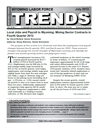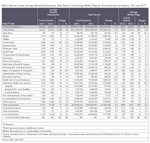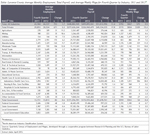Local Jobs and Payroll in Wyoming: Mining Sector Contracts in Fourth Quarter 2012
The purpose of this article is to illustrate and describe employment and payroll changes between fourth quarter 2011 and fourth quarter 2012. These economic changes help gauge the overall strength of Wyoming’s economy and identify the fastest and slowest growing sectors and geographic areas.
Total unemployment insurance (UI) covered payroll increased by $127.7 million (4.0%) in fourth quarter 2012. Employment rose by 866 jobs (0.3%) and average weekly wage increased by $32 (3.7%). In fourth quarter, total wages, employment, and average weekly wage grew slightly faster than their five year averages (see Table 1). However, large job losses in the mining sector (including oil & gas; -1,278 jobs, or -4.5%) caused overall job growth to slow to its lowest level in more than two years. Additionally, employment at temporary help agencies fell by nearly 400 jobs. Temporary employment is often cited nationally as a leading economic indicator, so this decrease may suggest continued weakness in the state’s economy. In terms of dollars, UI covered payroll represents approximately 91.5% of all wage and salary disbursements and 43.8% of personal income in the state (U.S. Bureau of Economic Analysis, 2013). Analysts have noted that “minerals related employment is one of the key predictors of sales and use tax revenue” in Wyoming (CREG 2010).
Despite the recent growth, overall employment remains approximately 8,600 jobs (3.0%) below its fourth quarter 2008 level. In short, the state has yet to make up all the job losses of 2009 and 2010.
The covered payroll and employment data in this article are tabulated by place of work, in contrast to the labor force estimates, which are a measure of employed and unemployed persons by place of residence. Also, the employment data presented in this article represent a count of jobs, not persons. When individuals work more than one job, each job is counted separately. Finally, job growth (or decline) is stated in terms of net change. The Quarterly Turnover Statistics by Industry table presents alternative measures of job gains and losses using the same data sources and calculated to describe the components of change.
Figure 1 shows Wyoming wage & salary employment by covered/non-covered status. Approximately 92% of wage & salary jobs in the state are covered by state unemployment insurance, while 2.6% of jobs are covered by federal unemployment insurance, and 0.9% are covered by unemployment insurance administered by the railroad retirement board. There are several categories of non-covered jobs, and together they account for approximately 5% of wage & salary jobs in the state. Some examples of non-covered employment include elected officials, students working at educational institutions, employees of churches, and workers at small non-profit organizations.
Figure 2 shows that the level of job growth fell from 2.5% in first quarter 2012 to 0.3% in fourth quarter, its slowest pace since third quarter 2010. Total payroll growth, which had slowed to 0.2% in third quarter, rebounded to 4.0% in fourth quarter (see Table 2). It is possible that the rebound in total payroll growth reflected employers paying bonuses in the fourth quarter in anticipation of tax increases they expected to occur in January.
Employment and Wages by County
Employment rose in 11 counties and fell in 12 counties (see Table 3). Total payroll increased in 19 counties and decreased in four counties.
Teton County added 534 jobs (3.4%) and its total payroll rose by $21.9 million (12.9%). Accommodation & food services added more than 300 jobs, while smaller gains occurred in administrative & waste services, professional & technical services, and real estate, rental, & leasing.
Employment in Converse County rose by 283 jobs (4.9%) and its total payroll grew by $7.2 million (11.0%). The largest job gains occurred in mining (including oil & gas; approximately 150 jobs), local government, and transportation & warehousing.
Carbon County gained 268 jobs (4.1%) and its total payroll increased by $0.4 million (0.6%). Construction added more than 150 jobs and modest gains were seen in retail trade and professional & technical services.
Sweetwater County’s employment increased by 227 jobs (0.9%) and its total payroll rose by $14.3 million (4.1%). Construction added more than 150 jobs and smaller increases occurred in health care & social assistance, accommodation & food services, retail trade, and wholesale trade. Job losses were seen in administrative & waste services, finance & insurance, and manufacturing.
Sublette County lost 939 jobs (-15.2%) and its total payroll fell by $11.4 million (-12.3%). Large job losses were seen in mining (including oil & gas; approximately 500 jobs) and construction (approximately 200 jobs).
Employment fell by 346 jobs (-5.7%) in Lincoln County and its total payroll decreased by $3.4 million (-5.1%). Construction lost approximately 150 jobs and employment also fell in mining (including oil & gas), accommodation & food services, and transportation & warehousing.
Campbell County’s employment decreased by 322 jobs (-1.1%), but its total payroll increased slightly ($2.6 million, or 0.7%). Mining employment (including oil & gas) fell by approximately 500 jobs and smaller job losses were seen in administrative & waste services, other services, and transportation & warehousing. Job gains occurred in local government (including public schools & hospitals; nearly 200 jobs), retail trade (more than 100 jobs), and utilities (approximately 100 jobs).
Uinta County lost 147 jobs (-1.6%), but its total payroll rose by $1.2 million (1.2%). Employment fell in construction (approximately 150 jobs) and local government.
Natrona County added 1,372 jobs (3.4%) and its total payroll rose by $43.4 million (8.7%). The largest job gains occurred in construction (420 jobs, or 15.6%), accommodation & food services (170 jobs, or 4.5%), wholesale trade (153 jobs, or 5.9%), and transportation & warehousing (123 jobs, or 11.4%).
Employment in Laramie County grew by 753 jobs (1.7%) and its total payroll increased by $51.0 million (11.4%). Construction added 172 jobs (6.2%) and growth was also seen in local government (including public schools, colleges, & hospitals; 145 jobs, or 2.0%), wholesale trade (106 jobs, or 12.8%), and retail trade (94 jobs, or 1.7%). Employment fell in manufacturing (-143 jobs, or -9.7%), federal government (-48 jobs, or -1.8%), and professional & technical services (-29 jobs, or -1.9%). It appears that total payroll and average weekly wage in retail trade and ambulatory health care services were affected by the payment of large bonuses.
Statewide Employment and Wages by Industry
The largest job gains occurred in accommodation & food services, local government (including public schools, colleges, & hospitals), retail trade, and health care & social assistance (see Table 4). Employment decreased in mining (including oil & gas), administrative & waste services, and construction.
Accommodation & food services added 822 jobs (2.8%) and its payroll rose by $6.2 million (5.1%). The majority of job gains occurred in food services & drinking places (approximately 550 jobs) while accommodation gained more than 250 jobs.
Local government gained 745 jobs (1.6%) and its total payroll grew by $14.8 million (3.2%). Local government education, which includes school districts and community colleges, added 226 jobs (0.9%) and hospitals added 279 jobs (4.2%).
Employment in retail trade grew by 336 jobs (1.1%) and its total payroll increased by $26.3 million (13.4%). Modest job gains were seen in many different areas of retail trade.
Health care & social assistance added 225 jobs (1.0%) and its total payroll rose by $26.3 million (10.4%). Job gains in ambulatory health care services (333 jobs, or 3.7%) more than offset losses at private hospitals (-158 jobs, or -4.9%).
Job losses in Wyoming’s mining sector continued to deepen in fourth quarter. Employment fell by 1,278 jobs (-4.5%) and total payroll fell by $2.4 million (-0.4%). Mining, except oil & gas lost approximately 200 jobs and support activities for mining (including oil & gas drilling and support services) lost more than 1,200 jobs. Employment rose in oil & gas extraction (nearly 200 jobs).
Administrative & waste services lost 384 jobs (-4.8%) and its payroll fell by $13.5 million (-18.4%). The largest job losses were found in employment services (including temporary help agencies; nearly 400 jobs). Job losses at temporary help agencies might suggest weak job growth in coming quarters.
Construction employment fell by 186 jobs (-0.8%), but its total payroll rose by $5.2 million (1.8%). Heavy & civil engineering construction lost approximately 500 jobs, while specialty trade contractors added approximately 250 jobs.
In summary, job losses in Wyoming’s mining sector (including oil & gas) grew deeper in fourth quarter, causing overall job growth to fall to its lowest level in two years. Sublette and Campbell counties were particularly affected by the loss of oil & gas jobs. However, solid job gains continued in Converse, Natrona, Teton, Niobrara, and Carbon counties.
References
Consensus Revenue Estimating Group (CREG; 2010, October) Wyoming state government revenue forecast fiscal year 2011-fiscal year 2016. Retrieved February 17, 2011 from http://eadiv.state.wy.us/creg/GreenCREG_Oct10.pdf
U.S. Bureau of Economic Analysis. (2013, January 16). SA04 State income and employment summary. Retrieved January 16, 2013, from http://tinyurl.com/n32avt6








